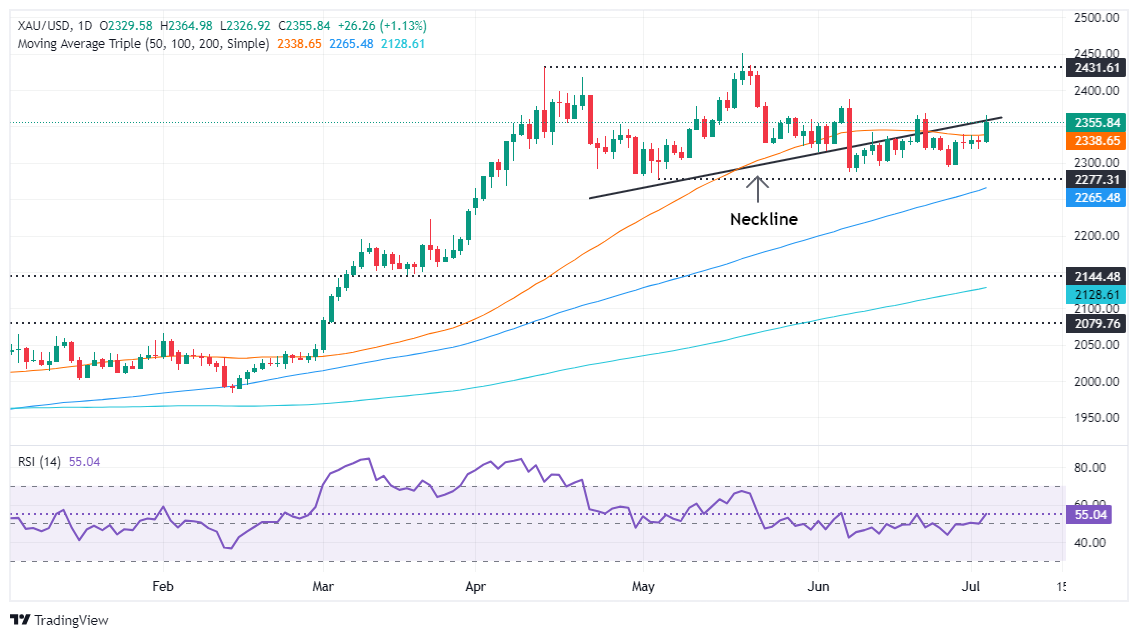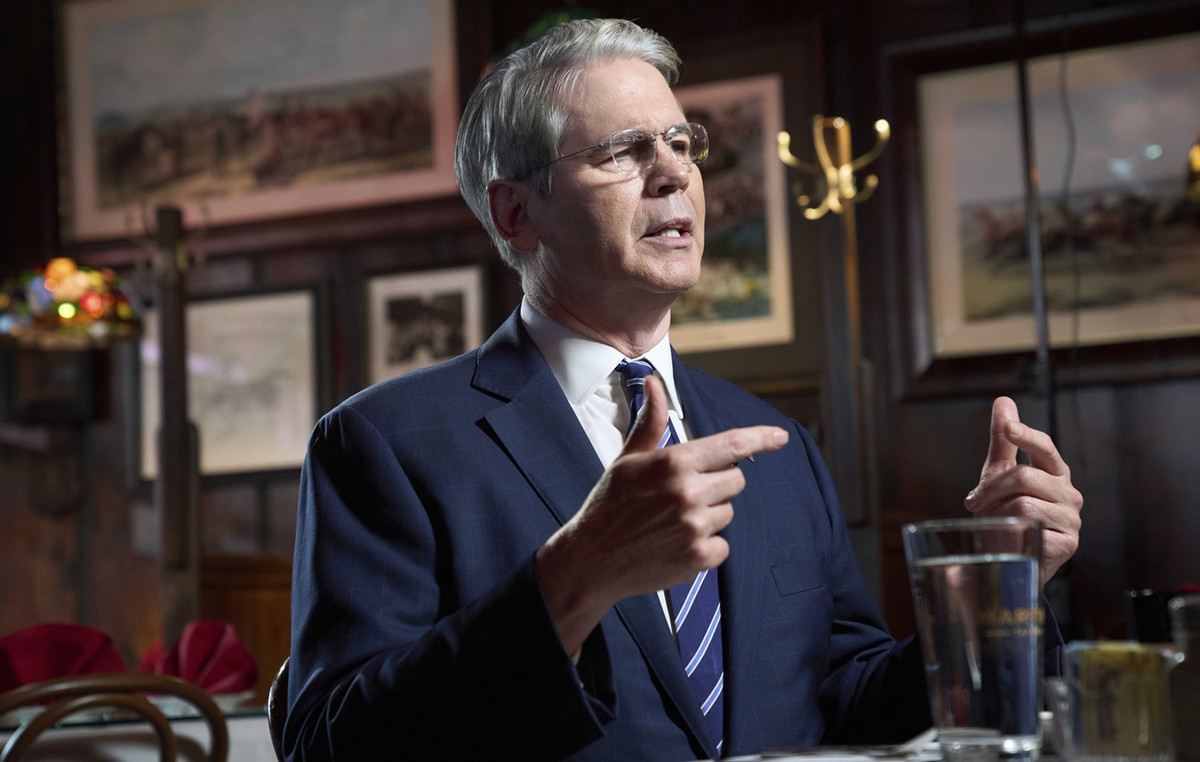- Gold rises, boosted by weak US economic data and growing expectations of Fed rate cuts.
- FOMC Minutes: There is a tendency toward a willingness to raise rates if inflation persists, but current policy is seen as restrictive.
- ISM shows a contraction in US services activity; labor market data reveals an increase in jobless claims and a decline in private hiring.
- The focus is on Friday’s Nonfarm Payrolls, with US markets closed on Thursday for Independence Day.
Gold prices rose more than 1% on Wednesday after weaker-than-expected US economic data raised bets that the Federal Reserve (Fed) could cut interest rates by September. Meanwhile, the latest FOMC meeting minutes showed that “several participants” were ready to raise rates if inflation remained elevated. At the time of writing, XAU/USD is trading $2,356 above its opening price.
The Fed minutes showed most participants viewed current policy as restrictive but opened the door to rate increases. Policymakers acknowledged that the economy is cooling and could react to unexpected economic weakness.
In addition, US business activity in the services sector contracted after hitting its highest level since August 2023, according to the Institute for Supply Management (ISM). This and weaker employment data, as the number of Americans applying for unemployment benefits rose and private companies hired fewer workers than expected, prompted a reassessment of the Fed’s interest rate cuts.
Labor market data surprisingly came in weaker following Tuesday’s JOLTS report, which was stronger than expected. Traders’ attention shifts to Friday’s Nonfarm Payrolls (NFP) report as U.S. markets will be closed on Thursday for Independence Day.
Market Movers: Gold Shines and Rises on Weak US Data
- On Tuesday, Powell said the disinflation process has resumed but stressed the need for more progress before considering any interest rate cuts. He added, “Because the U.S. economy is strong and the labor market is strong, we have the ability to take our time and get it right.”
- US employment data for June, led by ADP employment change, came in at 150,000, below estimates of 160,000 and below May’s 157,000.
- US initial jobless claims for the week ending June 29 rose to 238,000, beating estimates of 235,000 and the previous reading of 234,000.
- The ISM services PMI for June fell sharply to 48.8, its lowest level since May 2020 and the fastest decline in four years, signaling recessionary conditions.
- According to the CME FedWatch tool, the odds of a 25-basis-point Fed rate cut in September are 66%, up from 63% on Tuesday.
- The December 2024 federal funds rate futures contract implies the Fed will ease policy by just 38 basis points (bps) by year-end.
Technical Analysis: Gold Price Fluctuates Near the Neckline of the Head and Shoulders Pattern
The bullish trend in the price of Gold is set to continue and is testing the neckline of a head-and-shoulders chart pattern that has emerged since April 2024.
From a price action perspective, XAU/USD has a short-term bearish bias, but the overall trend is bullish and remains intact. This is further confirmed by the momentum as the RSI is bullish.
If the price of Gold breaks above the neckline of the pattern, that would sponsor a rise to $2,400 and invalidate the head-and-shoulders chart structure. This would pave the way for further gains and expose the year-to-date high of $2,450.
Conversely, if the sellers push the spot price below $2,350, a further decline is anticipated near $2,300. If successful, the next demand zone would be the May 3 low of $2,277, followed by the March 21 high of $2,222.
The Fed
Monetary policy in the United States is directed by the Federal Reserve (Fed). The Fed has two mandates: to achieve price stability and to promote full employment. Its main tool for achieving these goals is to adjust interest rates. When prices rise too quickly and inflation exceeds the Fed’s 2% target, the Fed raises interest rates, increasing borrowing costs throughout the economy. This translates into a strengthening of the US Dollar (USD), as it makes the US a more attractive place for international investors to park their money. When inflation falls below 2% or the unemployment rate is too high, the Fed can lower interest rates to encourage borrowing, which weighs on the greenback.
The Federal Reserve (Fed) holds eight meetings a year, at which the Federal Open Market Committee (FOMC) assesses economic conditions and makes monetary policy decisions. The FOMC consists of twelve Federal Reserve officials: the seven members of the Board of Governors, the president of the Federal Reserve Bank of New York, and four of the eleven regional Reserve bank presidents, who serve one-year terms on a rotating basis.
In extreme situations, the Federal Reserve may resort to a policy called Quantitative Easing (QE). QE is the process by which the Fed substantially increases the flow of credit into a jammed financial system. It is a non-standard policy measure used during crises or when inflation is extremely low. It was the Fed’s weapon of choice during the Great Financial Crisis of 2008. It involves the Fed printing more dollars and using them to buy high-quality bonds from financial institutions. QE typically weakens the US dollar.
Quantitative tightening (QT) is the reverse process of QE, whereby the Federal Reserve stops buying bonds from financial institutions and does not reinvest the capital of maturing bonds in its portfolio to buy new bonds. It is usually positive for the value of the US dollar.
Source: Fx Street
I am Joshua Winder, a senior-level journalist and editor at World Stock Market. I specialize in covering news related to the stock market and economic trends. With more than 8 years of experience in this field, I have become an expert in financial reporting.








